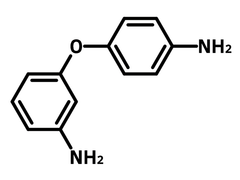3,4'-Oxydianiline (3,4'-ODA)
CAS Number 2657-87-6
Chemistry Building Blocks, COF Ligands, Diamines and Dianhydrides, Materials, Monomers, Non-Heterocyclic Building Blocks,An asymmetrical diamine building block
As intermediate for the preparation of polyimides in application of transparent substrates, organic porous materials, and pervaporation membranes
Specifications | MSDS | Literature and Reviews
3,4'-Oxydianiline (3,4'-ODA), CAS number 2657-87-6, is a phenyl ether derivative capped with two amines at para- and meta-position on either end. 3,4'-Oxydianiline is typically used for synthesizing polyimides with multi-functionalities. Due to the meta-substituted amine hindering the intermolecular packing, the polyimides are transparent. Therefore, they are applied as substrates in displays. The high thermal stability (210 °C) allows these polyimides to be used as substrates for sintering integrated devices.
3,4'-ODA is also used in synthesizing organic porous materials with BET surface area up to 351 m2/g. The polyetherimide membranes obtained from this diamine building block show effectiveness on pervaporation for water-isopropanol separation.
Oxydianiline building block
for the synthesis of COFs, OLED and organic photovoltaic materials
Worldwide shipping
Quick and reliable shipping
Capped with amine
for facile reactions
High purity
>99% Purity
General Information
| CAS Number | 2657-87-6 |
| Chemical Formula | C12H12N2O |
| Full Name | 3-(4-Aminophenoxy)aniline |
| Molecular Weight | 200.24 g/mol |
| Synonyms | 3,4′-DAPE, 3,4′-diaminodiphenyl ether, 3,4′-oxydiphenylamine, 3-(4-aminophenoxy)aniline |
| Classification / Family | Diamine building block, Transparent substrate, Polyimides, Pervaporation membranes |
Chemical Structure

Product Details
| Purity | >99% |
| Melting Point | Tm = 61 °C – 67 °C |
| Appearance | Pale yellow to reddish yellow powder/crystal |
MSDS Documentation
 3,4'-Oxydianiline (3,4'-ODA) MSDS Sheet
3,4'-Oxydianiline (3,4'-ODA) MSDS Sheet
Literature and Reviews
-
Comparison of properties of colorless and transparent polyimide films using various diamine monomers, H. Jeon et al, Rev. Adv. Mater. Sci., 62, 394-404(2022); DOI: 10.1515/rams-2022-0044.
-
Fabrication of gold-doped crystalline-silicon nanomembrane-based wearable temperature sensor, K. Kang et al., STAR protocols, 4(1), 101925(2023); DOI: 10.1016/j.xpro.2022.101925.
-
Solid-state thermal rectification of bilayers by asymmetric elastic modulus, J. Lee et al., Mater. Horiz., 10, 1431-1439(2023), DOI: 10.1039/d2mh01550a.
